PSSM in horses or Polysaccharide storage myopathy is a severe and inheritable glycogen storage disease characterized by muscle damage, stiffness, reluctance to move, and severe colic. The primary cause of the disease is overfeeding of readily digestible carbohydrates by the horse and genetic factors. Few horse breeds are more susceptible to PSSM than other breeds. The disease is characterized by muscular weakness, lethargy, reluctant to rise, muscle damage, increase serum creatinine, and reduced performance.
Most Interesting Facts of PSSM in Horses
In the typical system, excess glucose stirred in the liver cell and muscle cell as glycogen. The glycogen deposited in the cells is used for energy production. PSSM in horses is the abnormal deposition of polysaccharides (Glycogen) in the horse’s muscle cell. The disease is also known as Equine Polysaccharide Storage Myopathy (EPSM) or “tying up” of the horse. PSSM in horses is the most frustrating disease for a horse owner.

How Do Horses Get PSSM?
There are two types of PSSM in horses: Type-1 and Type-2. Type-1 PSSM is a disease because a specific cause has identified. The GYS1 gene carries the instruction for the enzyme glycogen synthase. This gene causes excessive synthesis of glucose into glycogen in the muscle cell. The type-2 PSSM is still a condition as the exact causes are unknown. In type-2 PSSM, glycogen deposited in the muscle cell abnormally and is not a normal phenomenon.

Breeds Susceptible to PSSM in Horses
Exertional Rhabdomyolysis is the result of PSSM in horses that may affect all breeds of horses. The most susceptible horse breeds are American Quarter Horse (AQH), American Paint Horse, Thoroughbred, Cobs, Warmbloods, Dales Ponies, New Forest Pony, Morgan, Peruvian Paso, Mustang, Lipizzaner, Standardbred, and the Arabian horse. Most of the draft horse breeds are more prone to PSSM as they feed more carbohydrates.
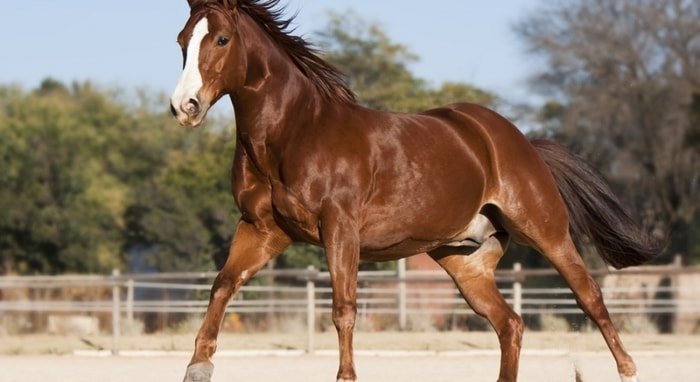
Types of EPSSM
Glucose is the end product of carbohydrate metabolism. The glucose is used for the production of energy within the cell by catabolism. The unused glucose stored in the liver cell and muscle cells as glycogen (a polymer of glucose). These stored glycogen are used for energy production (Glycolysis) during the additional requirement. Any disruption of the process leads to glycogen storage diseases or PSSM. There are two types of EPSSM:
- Type-1 PSSM: Due to the presence of an enzyme GYS1, which produces the glycogen synthase enzymes, excessive glycogen produces and stored in the muscle.
- Type-2 PSSM: This is due to abnormal deposition of glycogen in the muscular tissue of the horse without the presence of the GSY1 gene. The exact cause of the condition not yet known.
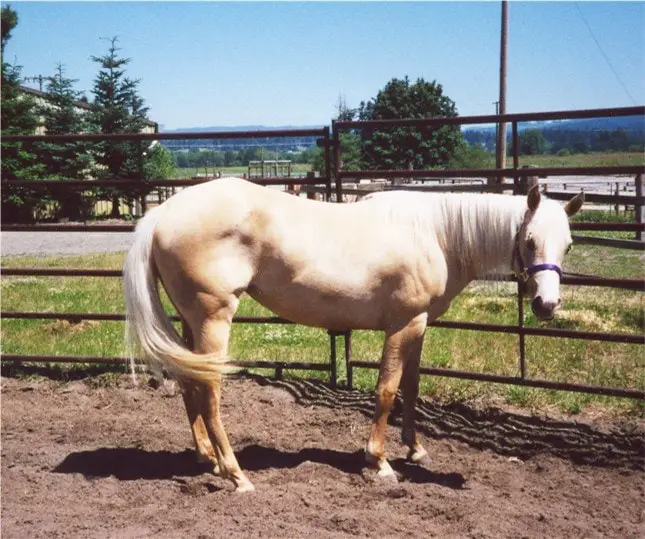
What are the Symptoms of PSSM in Horses?
The most common signs of PSSM in horses are “tying up” like symptoms due to excessive deposition of glycogen in the muscle cells. The condition is known as exertional Rhabdomyolysis. The other common signs are:
- Stiffness of legs.
- Shortened stride.
- Gait abnormalities.
- Firm musculature.
- Reluctance to move or exercise.
- Shifting lameness.
- Muscle weakness may lead to an inability to rise.
- Colic.
- Atrophy of neck and back muscle.
- Increase in Creatine Kinase enzyme in blood and urine.
- Concurrent Gastrointestinal or respiratory infections.
- Increased muscle damage due to creatine kinase enzymes.
- Painful, firm, and sore forming in the back and hindquarter muscle.
- A decrease in energy.
- Difficult in canter.
- Many horse lead to EPM, colic, gastric ulcers, laminitis, and lethargy.
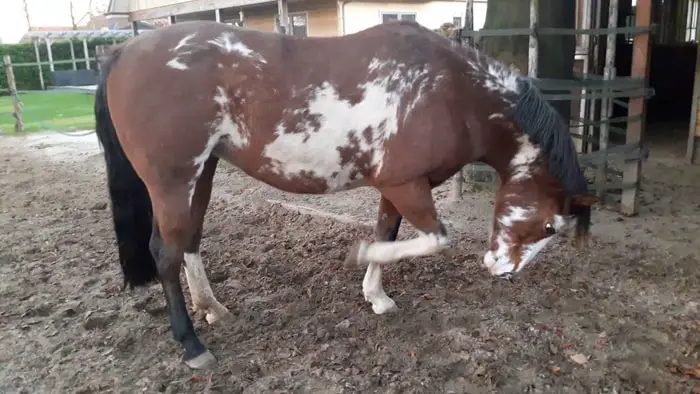
Diagnosis of Equine Polysaccharide Storage Myopathy
The disease’s initial or possible diagnosis can be made by clinical signs, history of the horses, breeds, and ancestral history of the dam and sire. Confirmatory diagnosis is made by the following means:
- Type1 PSSM is a genetic disease and can be diagnosed by a test of samples taken from blood and hair.
- Muscle biopsies can be done for the presence of glycogen in the muscle cells.
- Diagnosis of the GYS1 gene by in some reputed Equine Laboratory in the United States and Europe like Michigan University Equine Neuromuscular Diagnostic Laboratory, University of California, Laboklin in Europe.
- Type 2 PSSM is diagnosed by muscle biopsy for glycogen presence in the muscle cells and damage of muscle cells.

Management and Treatment of PSSM in Horses
There is no specific treatment available for EPSSM. After a confirmatory diagnosis of the disease, you can go for a few managemental procedures to correct the condition in your horse. The management of Equine Polysaccharide Storage Myopathy includes the combination of diet, exercise, and metabolism of carbohydrates within the cells.

What Do You Feed a PSSM Horse?
The success of the management of EPSSM is mostly based on the correct and balanced diet for the horse. The diet should be composed of low sugar and starch, not more than 1.5 to 2% of the horse’s body weight per day. The total non-structural carbohydrate (NSC) should not be not more than 12% of the diet. The horse diet should have vitamins, minerals, protein, and fat in a balanced way, and you can add a muscle development supplement with feed.
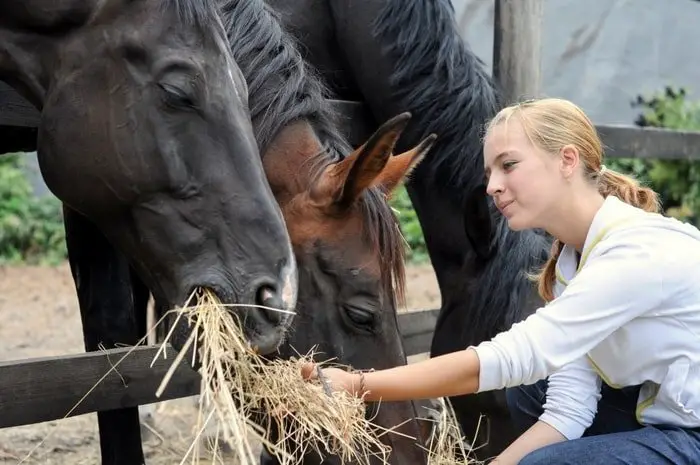
Exercise of Horse with PSSM
Regular exercise is the best way to prevent and manage PSSM in horses. The exercise should not be laborious for every day; instead, it should continue a regular structured work. The routine exercise includes walk, lunging, riding, and turnout. The exercise will help to burn the carbohydrate within the bloodstream, and less glucose will deposit to the muscle cells. You must avoid the complete rest of your horse.
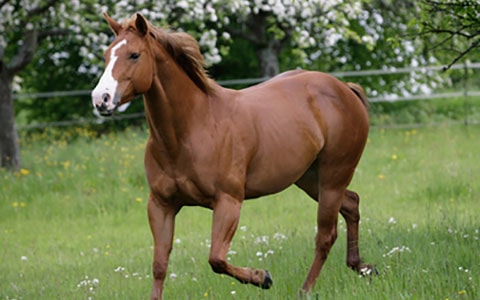
Final Advice on PSSM in Horses
Polysaccharide storage myopathy is a frustrating and frightening disease to many horse owners. The knowledge on the condition, how it occurs, the signs, and the mode of correction will reduce the owner’s tension. The condition can be corrected by a proper and timely diagnosis of the condition. The managemental guide also simple; diet and exercise. If you maintain a balanced diet and regular exercise of your house, in 75% of cases, the disease can be controlled. I think this short article will help you a lot. If you are benefited by reading, please share it with your friends who owned horses.